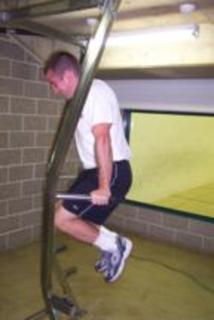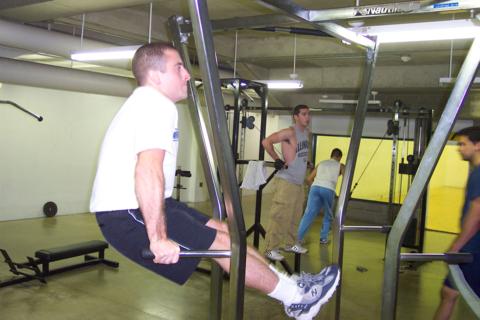Dips.
Description: Raising and lowering the body with the arms ar the side.
Motions trained: Pushing away from the chest.
Main muscles used: Pectoral or triceps
Other muscles: Abdominals, hip flexors (L-dips)
How to do it: Grab the bar with both hands. For a standard dip, raise and lower yourself.
If the bars adjust, get them so that the arms are not too far away. Your thumbs are pointing straight ahead of you.
If you stay bolt upright, you work the triceps mostly, if you tilt forward a bit, you work the pectorals.
lever first, then in that position, do your dips.
Make sure your back is flat and parallel with the ground. This is largely pectoral work. with a great
deal
of shoulkd stabilization required.
For L-dips, swing your legs in front of you and hold that position. This works the triceps and
requires abs, hip flexors and shoulders to stabilize.
How to work up to it:
Ramping it up: If you insist on adding weight (I have no idea why you'd want to,
by the way and if you feel you must either you are godzilla or aren't doing them right),
do the standard dip and hook a dumbbell with the top of your foot. When you need to put it
down, point your toes at the ground. To do these plyometrically, hop up and down the
bar using your hands while you do these. If you really want to ramp it up, to a horizontal
dip, then go into a handstand and return all the way to the down position.
Do's and don'ts: Do not work with various grips. They are a waste
of time and probably will make your elbows, wrists or shoulders hurt. Especially
avoid the extra wide grip or the inverted grip (so you hold with your pinkies to
the front rather than the rear).
Comments: No, there is no such thing as a one-handed dip.





